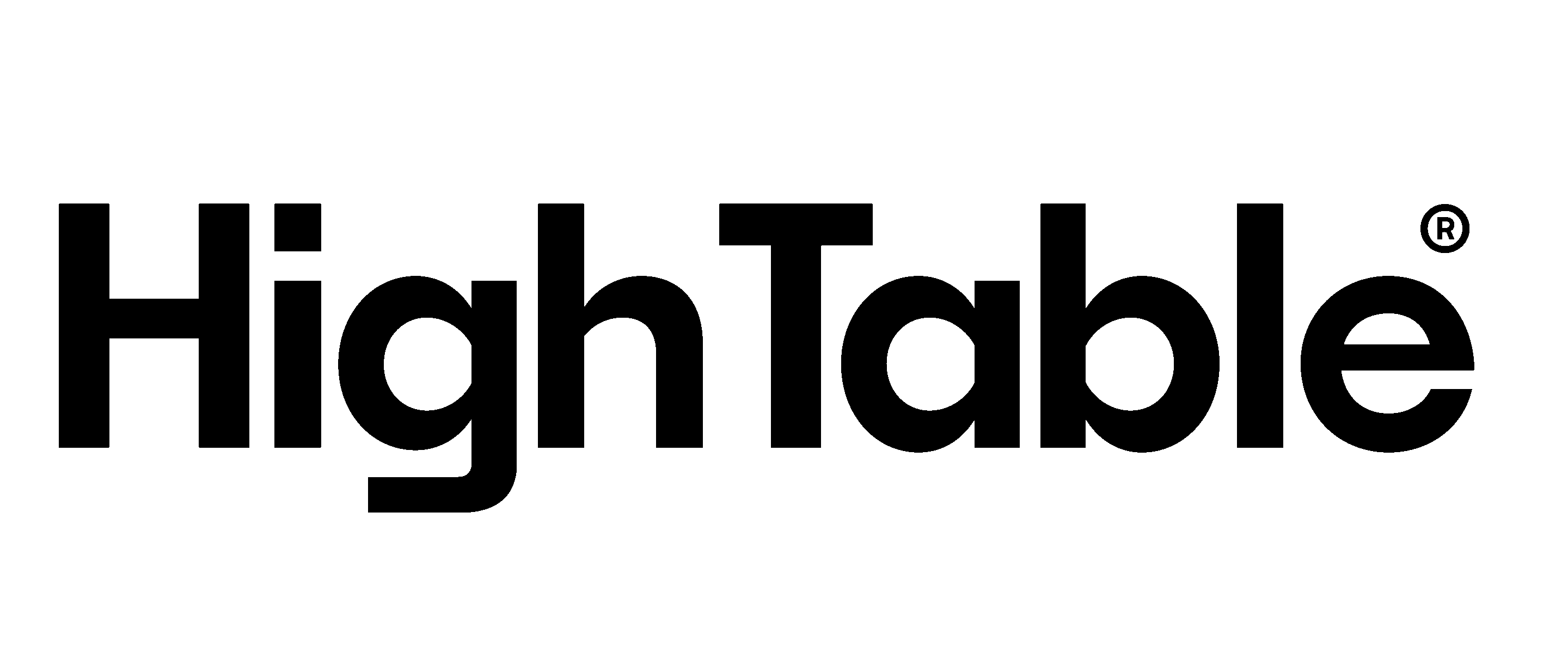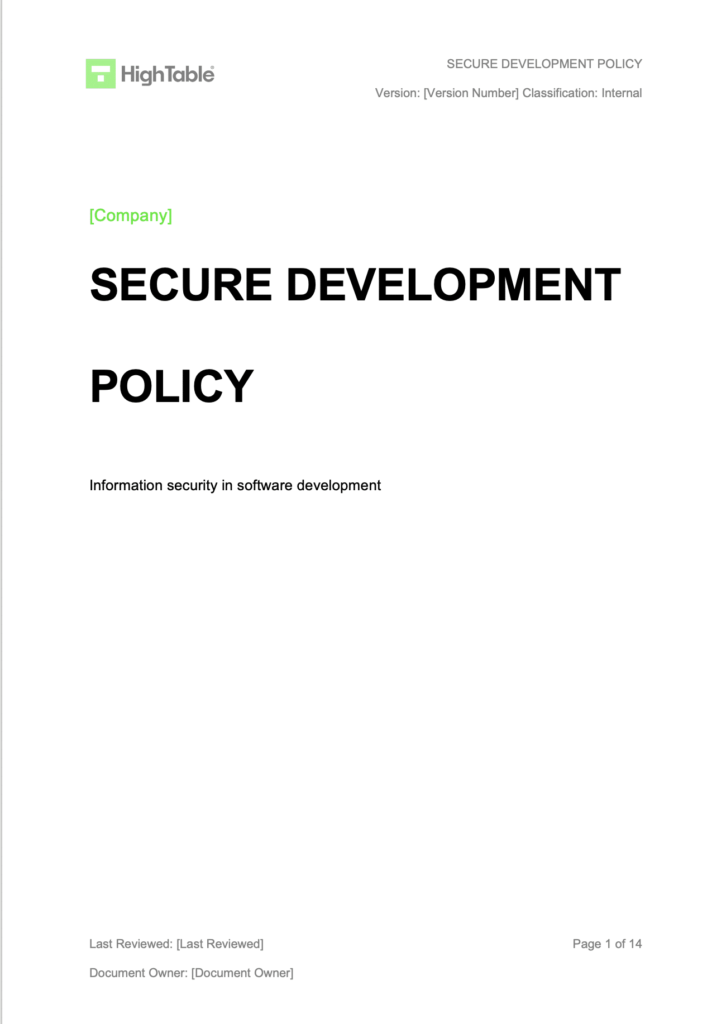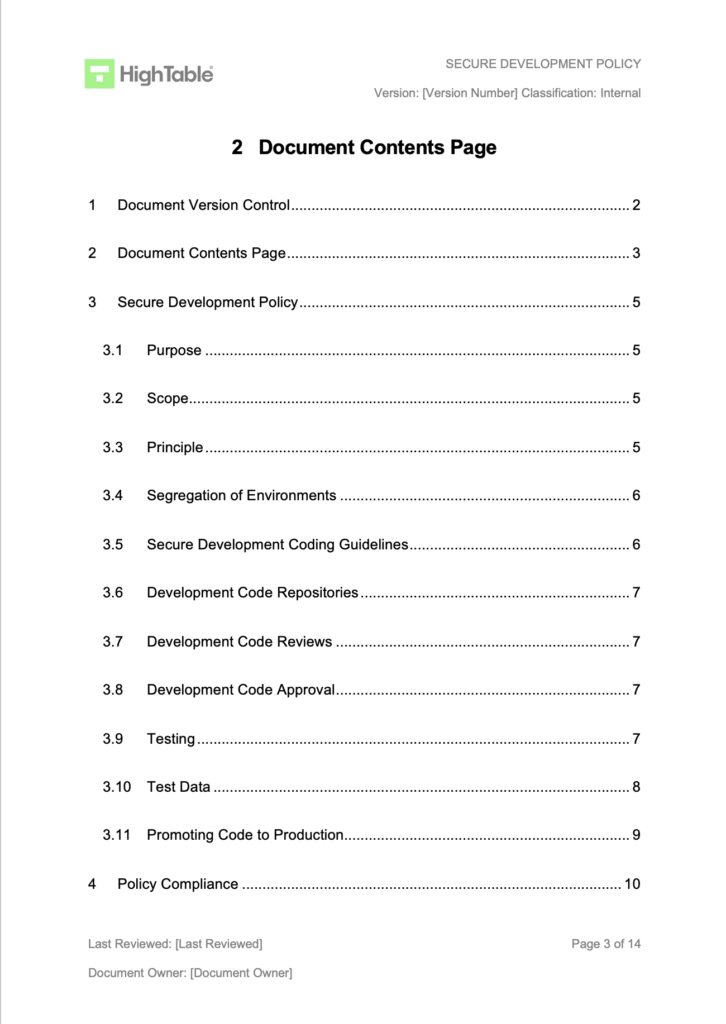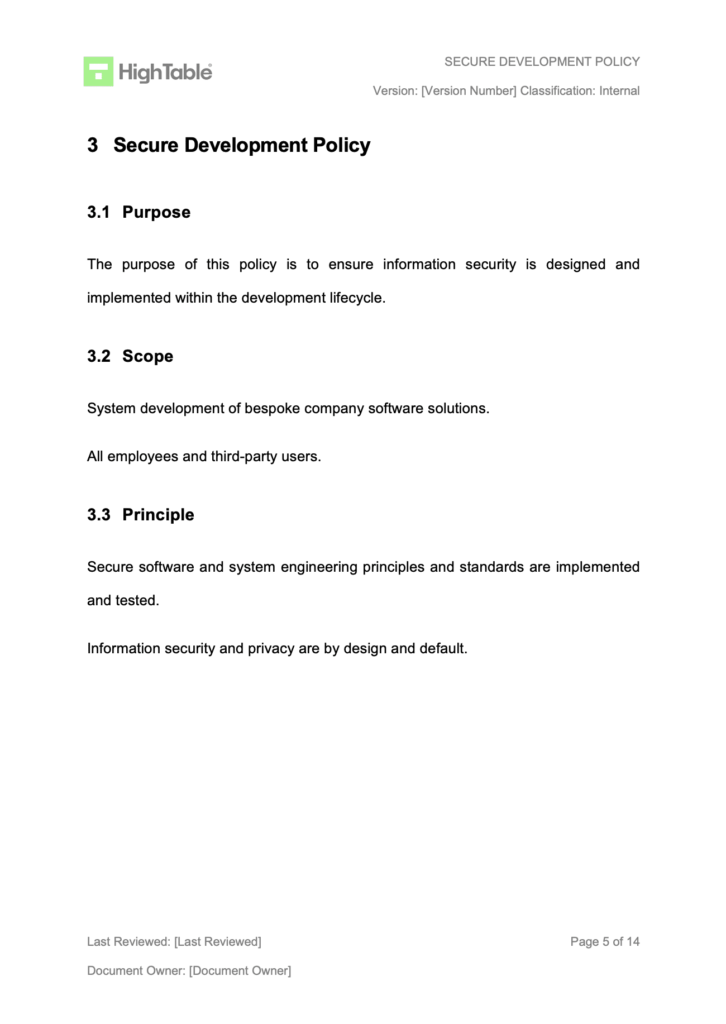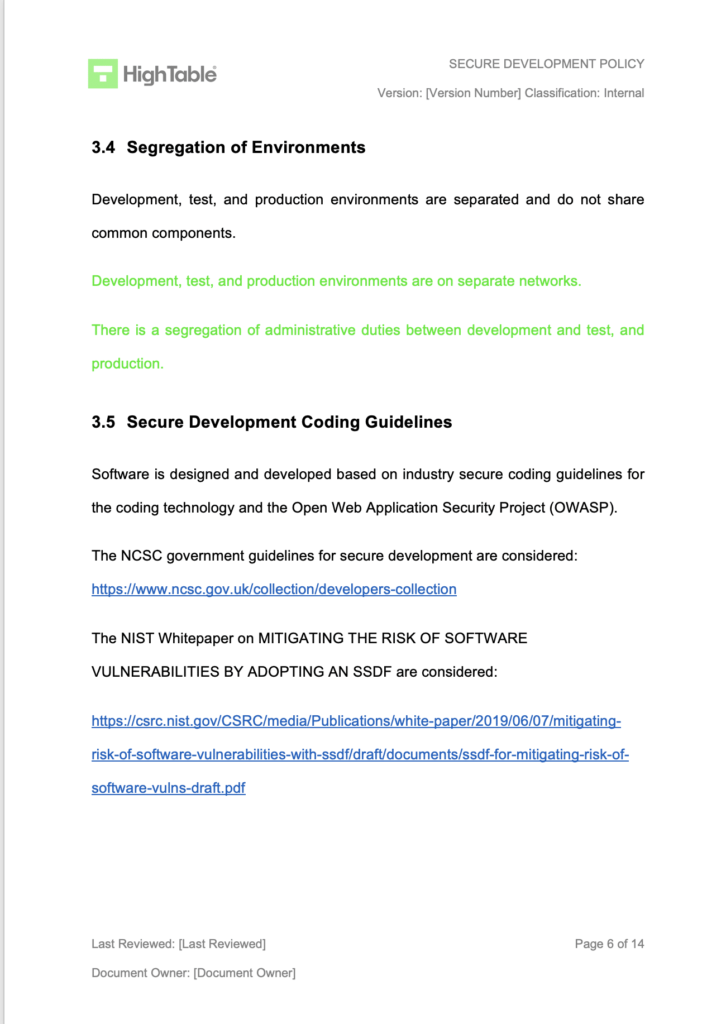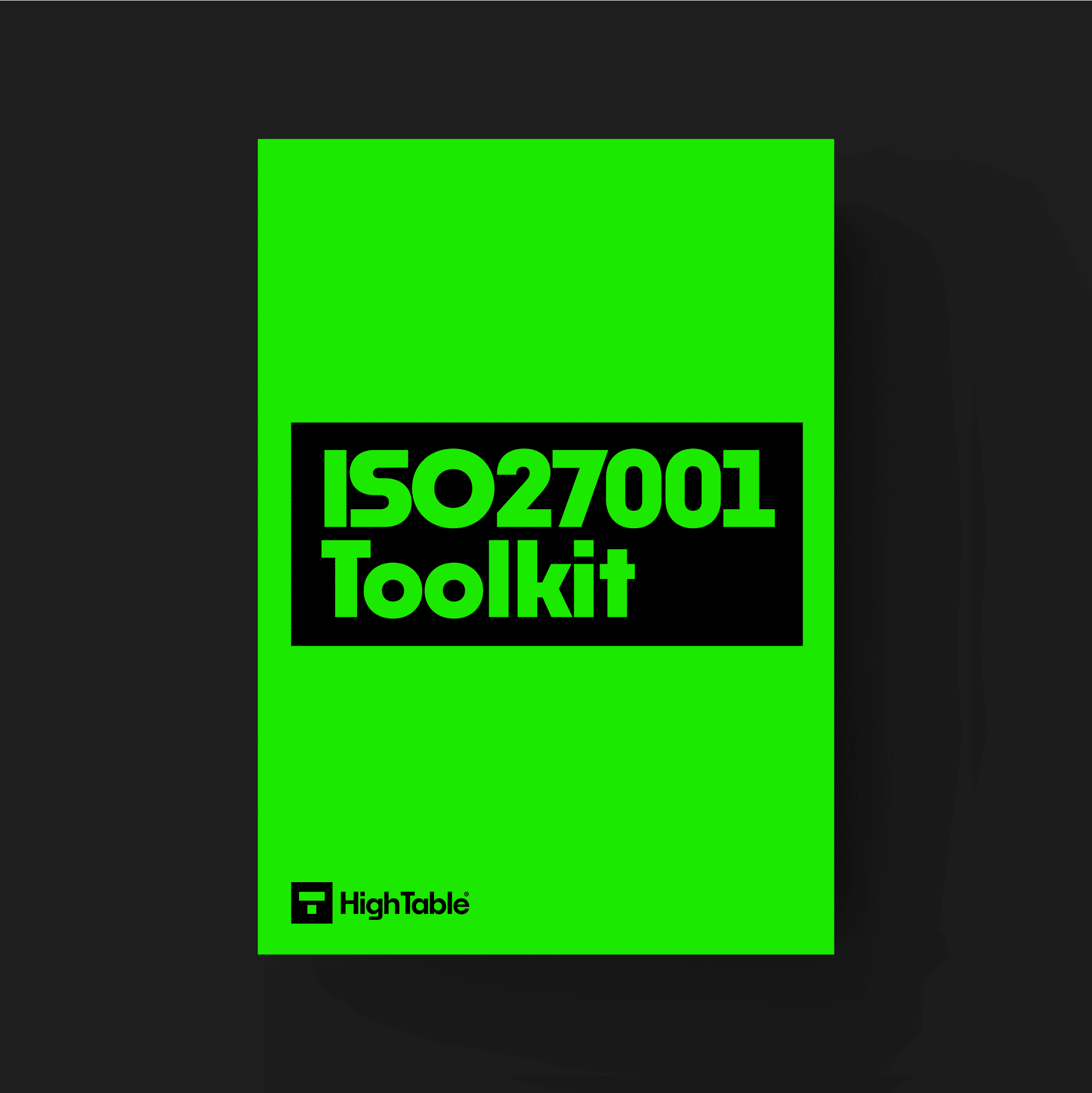The ISO 27001 Secure Development Policy sets out how you manage information security in your development lifecycle to protect the confidentiality, integrity and availability of data within applications.
Table of contents
- What is it?
- Applicability to Small Businesses, Tech Startups, and AI Companies
- ISO 27001 Secure Development Policy Template
- Why you need it
- When you need it
- Who needs it?
- Where you need it
- How to write it
- How to implement it
- Examples of using it for small businesses
- Examples of using it for tech startups
- Examples of using it for AI companies
- How the ISO 27001 toolkit can help
- Information security standards that need it
- List of relevant ISO 27001:2022 controls
- ISO 27001 Secure Development Policy Example
- ISO 27001 Secure Development Policy FAQ
What is it?
An ISO 27001 Secure Development Policy is a set of rules and guidelines that help you create software that’s safe and sound from the get-go. It’s part of the bigger ISO 27001 family, which is all about managing information security. This policy ensures that security isn’t just an afterthought but is woven into every step of your software-making process.
Applicability to Small Businesses, Tech Startups, and AI Companies
This policy is useful for businesses of all sizes, including small businesses, tech startups, and AI companies.
- Small Businesses: You might think ISO 27001 is too much, but it’s really about being smart with your resources. It gives you a structured way to think about security from the very beginning, helping you avoid costly mistakes later on. It’s a strong signal of trustworthiness to your customers and partners, which can set you apart from competitors.
- Tech Startups: Your reputation is everything. A single security incident could stop your growth cold. By following the ISO 27001 framework, you’re building a secure foundation that can handle rapid growth. It shows investors and potential clients that you’re a professional and responsible operation, which is a huge advantage.
- AI Companies: You’re handling a massive amount of data, and that comes with unique risks. ISO 27001 helps you secure the data life cycle, from collection to storage and processing. It ensures you’re protecting sensitive training data and algorithms, which are at the core of your business. This isn’t just a good idea—it’s essential for responsible AI development.
ISO 27001 Secure Development Policy Template
The ISO 27001:2022 Secure Development Policy Template is designed to fast track your implementation and give you an exclusive, industry best practice policy template that is pre written and ready to go. It is included in the ISO 27001 toolkit.
You can find templates for an ISO 27001 Secure Development Policy online. These templates give you a head start. You can then change them to fit your specific business needs. Using a template can save you time and help you make sure you don’t miss anything important.
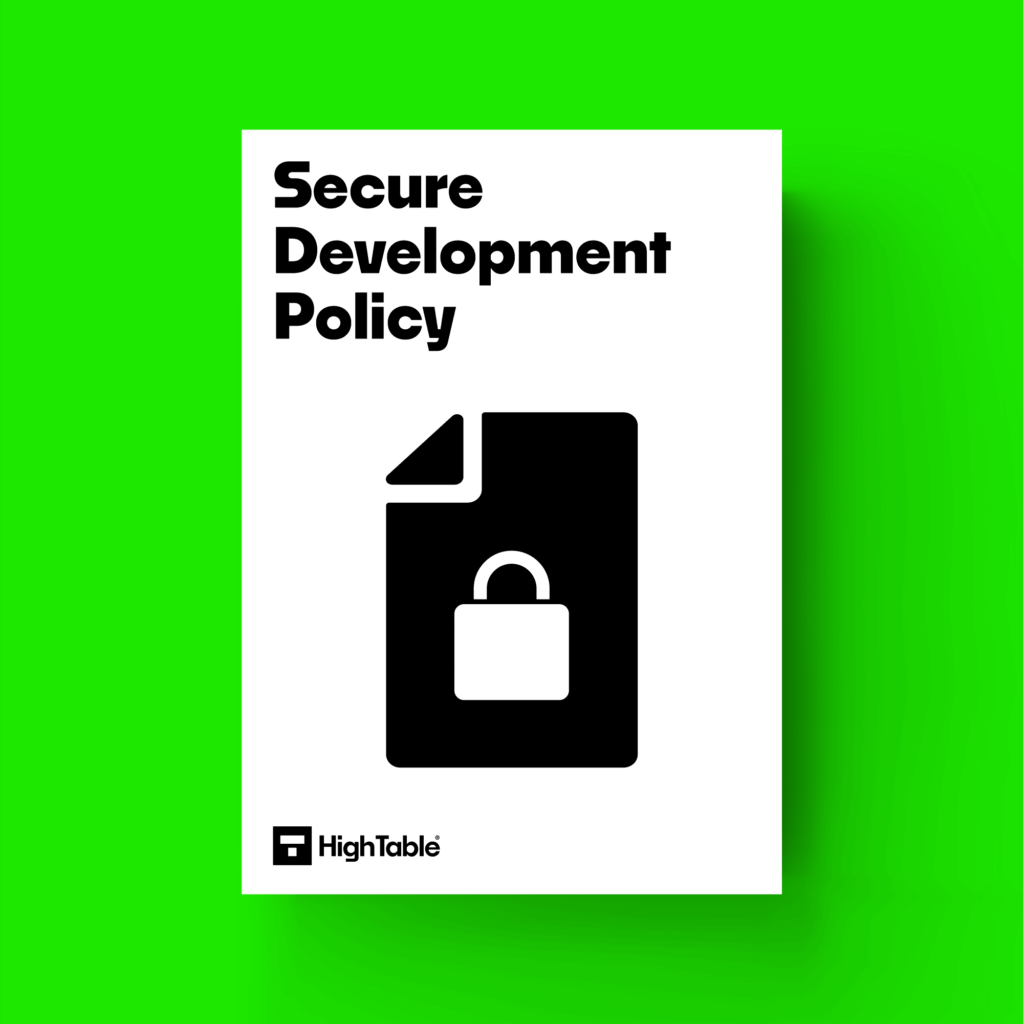
Why you need it
You need this policy because it’s way easier to build security in than to try and tack it on later. It helps you avoid costly mistakes, protects your reputation, and keeps your customers’ data safe. Plus, it shows everyone that you’re serious about security, which is a big plus for business.
When you need it
You need a secure development policy right from the start of your software journey. The earlier, the better! You’ll use it when you’re planning new features, coding, and even when you’re getting ready to launch your product. It’s a continuous process, not a one-time thing.
Who needs it?
Anyone who builds software needs this policy! This includes developers, project managers, and anyone involved in creating or maintaining your digital products. It’s a team effort to keep things secure.
Where you need it
You need this policy everywhere you create software. It’s for your office, for your remote workers, and for any tools or platforms you use for development. It’s a rulebook that follows you wherever your work takes you.
How to write it
Writing a good policy is all about keeping it simple and clear. You should explain the what, why, and how of secure development. Talk about things like testing your code, managing access to sensitive info, and how to handle security issues. Use easy-to-understand language so everyone can follow it.
Time needed: 1 hour and 30 minutes
How to write an ISO 27001 Secure Development Policy
- Create your version control and document mark-up
ISO 27001 documents require version control of the author, the change, the date and the version as well as document mark up such as document classification.
- Write the ISO 27001 Secure Development Policy contents page
Document Version Control
Document Contents Page
Secure Development Policy
Purpose
Scope
Principle
Segregation of Environments
Secure Development Coding Guidelines
Development Code Repositories
Development Code Reviews
Development Code Approval
Testing
Test Data
Promoting Code to Production - Write the ISO 27001 Secure Development Policy purpose
The purpose of this policy is to ensure information security is designed and implemented within the development lifecycle.
- Write the ISO 27001 Secure Development Policy principle
System development of bespoke company software solutions.
All employees and third-party users. - Write the ISO 27001 Secure Development Policy scope
Secure software and system engineering principles and standards are implemented and tested.
Information security and privacy are by design and default. - Describe the segregation of environments
Development, test, and production environments are separated and do not share common components.
Development, test, and production environments are on separate networks.
There is a segregation of administrative duties between development and test, and production. - Explain the secure development coding guidelines
Software is designed and developed based on industry secure coding guidelines for the coding technology and the Open Web Application Security Project (OWASP).
The NCSC government guidelines for secure development are considered.
The NIST White-paper on MITIGATING THE RISK OF SOFTWARE VULNERABILITIES BY ADOPTING AN SSDF are considered. - Define the use of development code repositories
Development code is stored in a secure code repository that enforces and meets the requirements of the access control policy and segregation of duty.
Development code repositories enforce version control and appropriate version archiving. - Explain the approach to development code reviews
Code is reviewed prior to release by skilled personnel other than the code author / developer.
Code is reviewed against the secure development coding guidelines.
Code reviews employ manual and automated techniques. - Describe development code approval
Code is approved before being promoted into test or production.
- Define testing
All pre-production testing occurs in a test environment.
The test environment mirrors as far as possible the production environment.
Application security testing is performed using manual and automated techniques.
Testing is performed that as a minimum test for the OWASP top 10.
External penetration testing is performed prior to initial release and then periodically or after a significant change.
All public facing web applications are tested using manual or automated vulnerability security tools or methods at least annually or after a significant change.
All vulnerabilities identified as part of the testing phase including penetration testing are corrected prior to promotion to production or managed via the risk management process.
Test results including penetration testing are additionally reported to the Management Review Team.
All penetration testing is conducted by an external specialist company. - Give guidelines on the use of test data
Production data is never used for testing or development.
Card holder data is never used for testing or development.
Personal data is never used for testing or development.
If sensitive information is required as part of the testing process it is:
– sanitised,
– anonymised or
– pseudo anonymised. - Explain promoting code to production
Code is promoted to production by approved personnel and is subject to the documented change control process.
The production environment is backed up prior to the promotion of code to production to facilitate roll back for a failed change.
Test data is removed before the application is promoted to production.
No development files or test data are stored in the production environment.
How to implement it
Implementing the policy is the fun part! You’ll train your team on the new rules, set up security checks in your workflow, and make sure everyone knows their role in keeping things secure. You’ll also want to check in regularly to make sure the policy is working and make tweaks as needed.
Examples of using it for small businesses
Let’s say you’re a small online shop. Your policy might include simple rules like: always use strong passwords, test your website for security holes before going live, and never store customer credit card numbers on your server.
Examples of using it for tech startups
If you’re a startup building a new app, your policy could cover things like: using secure coding practices (like input validation), doing regular security reviews of your code, and setting up a way for users to report security bugs to you.
Examples of using it for AI companies
For an AI company, your policy is super important. It might include rules like: protecting the data you use to train your models, making sure your AI can’t be tricked into doing something bad, and keeping your AI’s secrets safe from competitors.
How the ISO 27001 toolkit can help
An ISO 27001 toolkit is like a toolbox full of pre-made documents and guides. It gives you a head start on creating your policy and other important security documents, saving you a ton of time and effort. It’s a great way to make sure you don’t miss anything.

Information security standards that need it
This policy is a key part of ISO 27001, which is an international standard for managing information security. Other standards that need it include:
- GDPR (General Data Protection Regulation)
- CCPA (California Consumer Privacy Act)
- DORA (Digital Operational Resilience Act)
- NIS2 (Network and Information Security (NIS) Directive)
- SOC 2 (Service Organisation Control 2)
- NIST (National Institute of Standards and Technology)
- HIPAA (Health Insurance Portability and Accountability Act)
List of relevant ISO 27001:2022 controls
The ISO 27001:2022 standard has specific controls that relate to secure development. Some of the most important ones include:
- ISO 27001:2022 Annex A 8.25 Secure Development Life Cycle
- ISO 27001:2022 Annex A 8.26 Application Security Requirements
- ISO 27001:2022 Annex A 8.27 Secure Systems Architecture and Engineering Principles
- ISO 27001:2022 Annex A 8.28 Secure Coding
- ISO 27001:2022 Annex A 8.29 Security Testing in Development and Acceptance
- ISO 27001:2022 Annex A 8.30 Outsourced Development
- ISO 27001:2022 Annex A 8.31 Separation of Development, Test and Production Environments
ISO 27001 Secure Development Policy Example
An example ISO 27001 Secure Development Policy:
ISO 27001 Secure Development Policy FAQ
The main goal is to make sure security is a core part of your software from the very beginning.
Nope! It’s for any size company that builds software.
No, you don’t! You can use templates and get help from experts if you need it.
It can take anywhere from a few hours to a few weeks, depending on how detailed you want to be.
Not following it can lead to security breaches, lost data, and a damaged reputation.
No, it’s a living document that you should review and update regularly.
It’s a good idea to review it at least once a year.
You need to explain it in simple terms and offer training so everyone gets it.
No, it works with them. The policy tells you how to use your tools wisely.
A policy is a high-level rule, while a procedure is a step-by-step guide on how to follow that rule.
No, it’s for any kind of software, including mobile apps and desktop programs.
It protects your data, builds customer trust, and can save you from a lot of trouble later on.
The first step is to decide who will be in charge of writing and implementing it.
